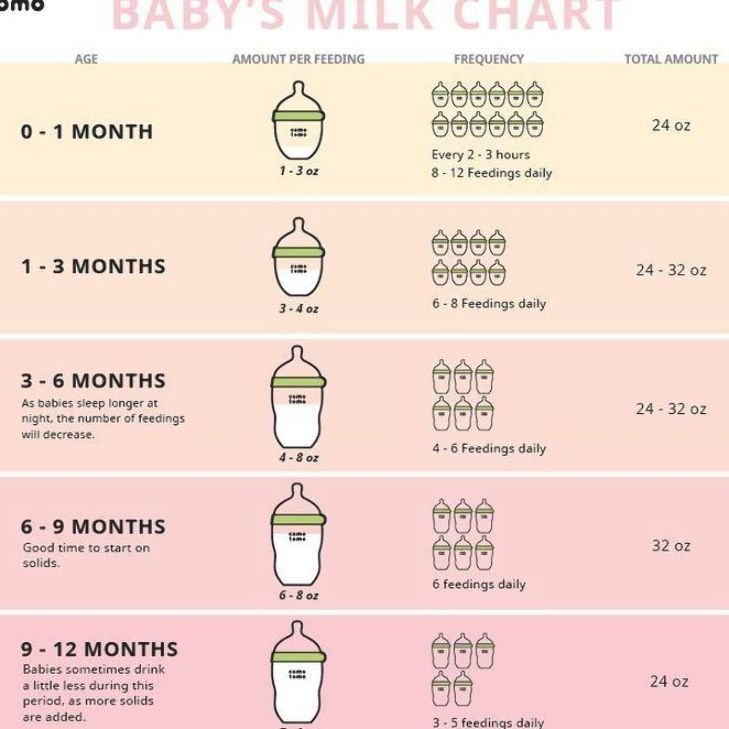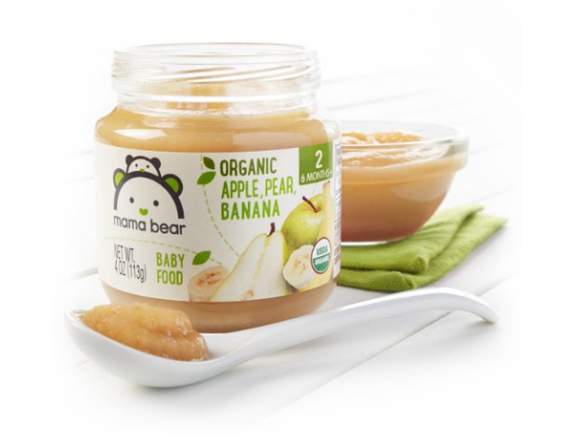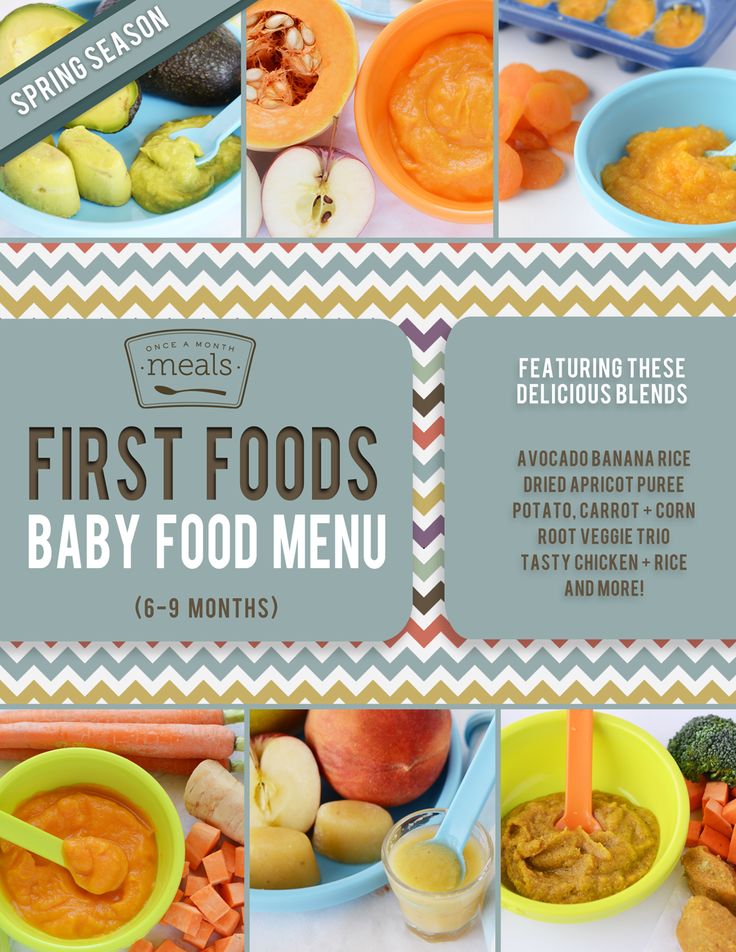Feeding time table for babies
Tips for the First Year
Every baby may get hungry on their own unique schedule. That said, most infants in the first months of life will eat every 2-4 hours, depending if they are nursing or drinking formula. Once they eat solids, they’ll gradually drink less.
Eat, sleep, pee, poop, repeat. Those are the highlights of a day of the life of a brand-new baby.
And if you’re a new parent, it’s the eating part that may be the source of many of your questions and worries. How many ounces should your baby take? Do you wake a sleeping baby to eat? Why do they seem hungry all the time? When can your child start solids?
Questions abound — despite Grandma’s insistence, the answers have changed since you were a tot. It’s now recommended that newborns, even formula-fed ones, eat on demand (consider it good preparation for the teenage years) and that babies wait to start solid foods until they’re 4 to 6 months old.
On day one of life, your baby’s stomach is the size of a marble and can only hold 1 to 1. 4 teaspoons of liquid at a time. As your baby gets older, their stomach stretches and grows.
It’s hard (or impossible, really) to know how much milk your baby is taking in while breastfeeding. But if you’re bottle feeding due to any number of valid reasons, it’s a bit easier to measure.
Here, from the American Academy of Pediatrics (AAP), a typical feeding schedule for bottle-fed babies.
| Age | Ounces per feeding | Solid foods |
|---|---|---|
| Up to 2 weeks of life | .5 oz. in the first days, then 1–3 oz. | No |
| 2 weeks to 2 months | 2–4 oz. | No |
| 2–4 months | 4-6 oz. | No |
| 4–6 months | 4–8 oz. | Possibly, if your baby can hold their head up and is at least 13 pounds. But you don’t need to introduce solid foods yet. |
| 6–12 months | 8 oz. | Yes. Start with soft foods, like one-grain cereals and pureed vegetables, meats, and fruits, progressing to mashed and well-chopped finger foods.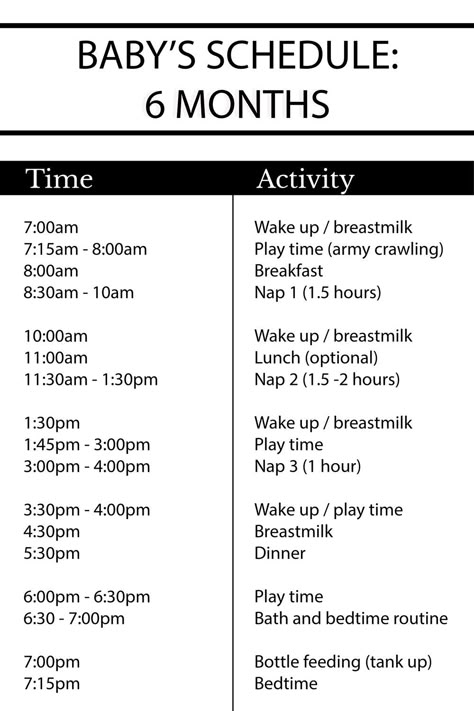 Give your baby one new food at a time. Continue supplementing with breast or formula feedings. Give your baby one new food at a time. Continue supplementing with breast or formula feedings. |
Every baby is unique — but one thing that’s pretty consistent is that breastfed babies eat more frequently than bottle-fed ones. That’s because breast milk is easily digested and empties from the stomach a lot quicker than formula.
Breastfed babies
There’s no rest for the weary. According to La Leche League International, you should begin nursing your baby within 1 hour of birth and provide about 8 to 12 feedings daily in the first few weeks of life (yeah, we’re exhausted for you).
At first, it’s important not to let your baby go more than 4 hours without feeding. You’ll likely need to wake them up if necessary, at least until breastfeeding is well established and they’re gaining weight appropriately.
As your baby grows and your milk supply amps up, your baby will be able to take in more milk in less time at one feeding. That’s when you might start to notice a more predictable pattern.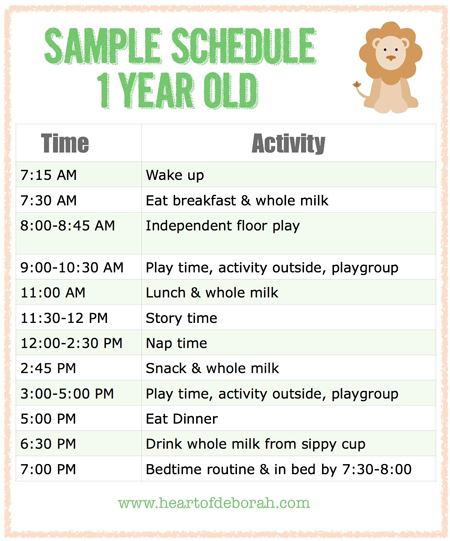
- 1 to 3 months: Your baby will feed 7 to 9 times per 24 hours.
- 3 months: Feedings take place 6 to 8 times in 24 hours.
- 6 months: Your baby will feed around 6 times a day.
- 12 months: Nursing may drop to about 4 times a day. The introduction of solids at about 6 months helps to fuel your baby’s additional nutritional needs.
Keep in mind that this pattern is just one example. Different babies have different paces and preferences, along with other factors that influence the frequency of feedings.
Bottle-fed babies
Like breastfed babies, bottle-fed newborns should eat on demand. On average, that’s about every 2 to 3 hours. A typical feeding schedule may look like this:
- Newborn: every 2 to 3 hours
- At 2 months: every 3 to 4 hours
- At 4 to 6 months: every 4 to 5 hours
- At 6+ months: every 4 to 5 hours
For both breastfed and bottle-fed babies
- Don’t give liquids other than formula or breast milk to babies under a year old.
 That includes juices and cow’s milk. They don’t provide the right (if any) nutrients and can be upsetting to your baby’s tummy. Water can be introduced around 6 months when you start offering a cup.
That includes juices and cow’s milk. They don’t provide the right (if any) nutrients and can be upsetting to your baby’s tummy. Water can be introduced around 6 months when you start offering a cup. - Don’t add baby cereal to a bottle.
- It can create a choking hazard.
- A baby’s digestive system isn’t mature enough to handle cereal until about 4 to 6 months of age.
- You could overfeed your baby.
- Don’t give your baby any form of honey until after their first birthday. Honey can be dangerous for a baby, occasionally causing what’s called infant botulism.
- Do adjust your expectations based on your baby and their unique needs. Premature babies are likely to follow feeding patterns according to their adjusted age. If your baby has challenges like reflux or failure to thrive, you may need to work with your doctor on the appropriate feeding schedule and amount they should be eating.
Schedules are the holy grail of every parent. Your child will naturally start to fall into a feeding pattern as their tummy grows and they can take in more breast milk or formula at one sitting. This may begin to happen between 2 and 4 months of age.
This may begin to happen between 2 and 4 months of age.
For now, though, focus on learning your baby’s hunger cues, such as:
- rooting around your chest, looking for a nipple.
- putting their fist in their mouth
- smacking or licking their lips
- fussing that can escalate quickly (don’t wait until your baby’s hangry to feed them)
Once your baby is a few months old, you may be able to introduce a sleep/feed schedule that works for you.
Let’s say, for example, your 4-month-old wakes every 5 hours for a feeding. That means if you feed at 9 p.m., your baby wakes around 2 a.m. But if you wake and feed the baby at 11 p.m., just before you go to bed, they may not rouse until 4 a.m., giving you a decent chunk of nighttime winks.
In general, if your baby seems hungry, feed them. Your baby will naturally eat more frequently during growth spurts, which typically occur around 3 weeks, 3 months, and 6 months of age.
Some babies will also “cluster feed,” meaning they’ll feed more frequently during certain periods and less at others.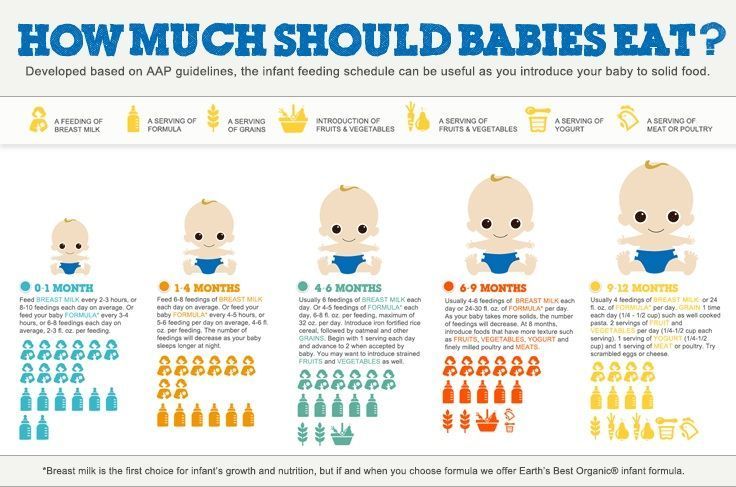 For example, your baby may cluster feed during the late afternoon and evening and then sleep longer at night (yay!). This is more common in breastfed babies than bottle fed babies.
For example, your baby may cluster feed during the late afternoon and evening and then sleep longer at night (yay!). This is more common in breastfed babies than bottle fed babies.
Worried about overfeeding? While this isn’t really possible to do with an exclusively breastfed baby, you can overfeed a baby who’s taking a bottle — especially if they’re sucking on the bottle for comfort. Follow their hunger cues, but talk to your pediatrician if you’re worried your little one may be overeating.
Your baby is probably ready for solids if they’re 4 to 6 months old and:
- have good head control
- seem interested in what you’re eating
- reach for food
- weigh 13 or more pounds
Which food to start with? The AAP now says it doesn’t really matter much in what order you introduce foods. The only real rule: Stick with one food for 3 to 5 days before offering another. If there’s an allergic reaction (rash, diarrhea, vomiting are common first signs), you’ll know which food is causing it.
As your baby grows, move from pureed baby food to ones that have more texture (for example, mashed banana, scrambled egg, or well-cooked, chopped pasta). This generally happens around 8 to 10 months of age.
Your supermarket offers a variety of baby food products, but if you want to make your own, keep it sugar and salt free. Additionally, at this stage, don’t feed your baby anything that could be a choking hazard, including:
- hard foods, such as popcorn or nuts
- hard, fresh fruits, like apples; cook to soften or chop into very small pieces
- any meat that isn’t well cooked and very well chopped (this includes hot dogs)
- cheese cubes
- peanut butter (though talk to your pediatrician about this one — and the benefits of introducing diluted peanut butter before the age of 1)
As your baby nears their first birthday, they should be eating a variety of foods and taking in about 4 ounces of solids at each meal. Continue to offer breast milk or formula.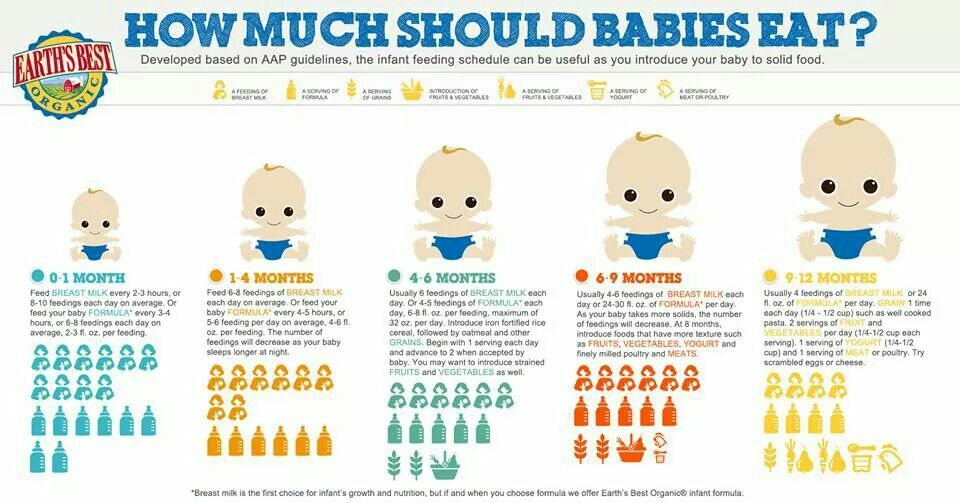 By 8 months, babies are drinking about 30 ounces a day.
By 8 months, babies are drinking about 30 ounces a day.
Oh yeah, and buy some stock in a company that makes stain-fighting laundry detergent. It’ll pay for college.
Babies aren’t cookie cutter. Some will gain weight easily, while others will have problems. Things that can affect a baby’s weight gain include:
- having a birth defect like a cleft lip or palate, which creates problems feeding
- having a milk protein intolerance
- being premature
- being fed with a bottle versus the breast
A 2012 study of more than 1,800 babies found that the infants who were fed with a bottle — regardless of whether the bottle contained breast milk or formula — gained more weight in the first year than babies who nursed exclusively.
Your baby’s doctor is the best one to advise you on a healthy weight range for your baby.
How, when, and what to feed a baby are top worries of every parent — but there’s good news: Most babies are pretty good judges of when they’re hungry and when they’re full — and they’ll let you know it.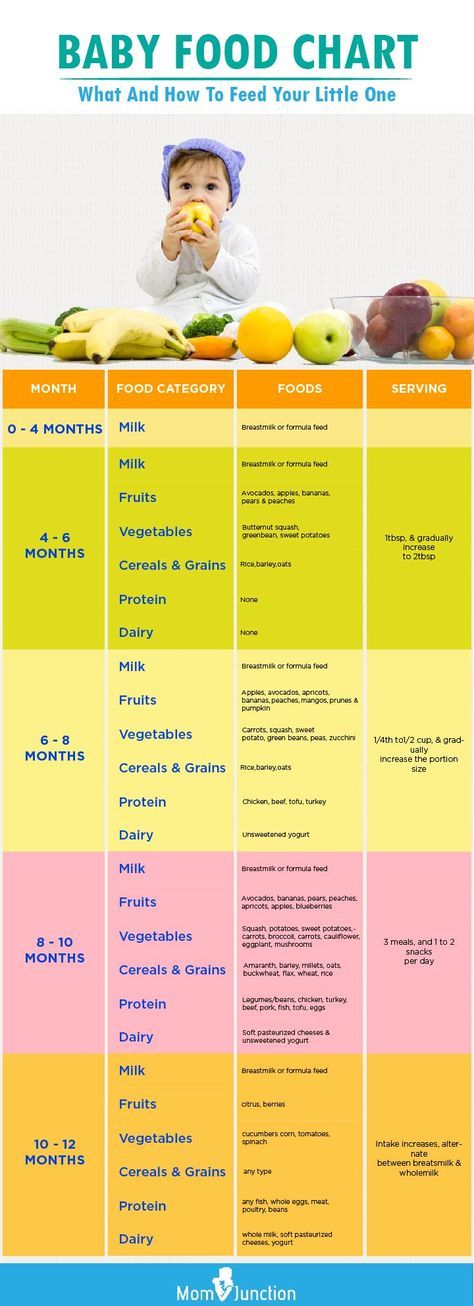
You just need to present them with the right choices at the right time and pay attention to their cues. If you have any questions or concerns, your pediatrician is there to help you along the way.
Newborn and Baby Feeding Chart in the 1st Year
Whether you’re a first-time parent or a seasoned caregiver, figuring out why your baby is crying can feel like a guessing game. Fortunately, paying attention to your baby’s daily feeding schedule can help reduce some of the guesswork.
By following a feeding schedule, you might be able to avoid some of the fussiness associated with hunger, and you’ll be able to more easily tell whether he’s more likely to be wet or tired instead.
Whether your little one’s a newborn, a 6-month old, or even a 1-year-old, read on to find out how to come up with a feeding schedule and adjust it to your baby’s needs as he grows and develops.
Baby Feeding Chart at a Glance
As you watch for those delightful baby milestones — from first smiles and giggles to sitting and crawling — it can be hard to keep track of everything related to your baby’s feeding schedule.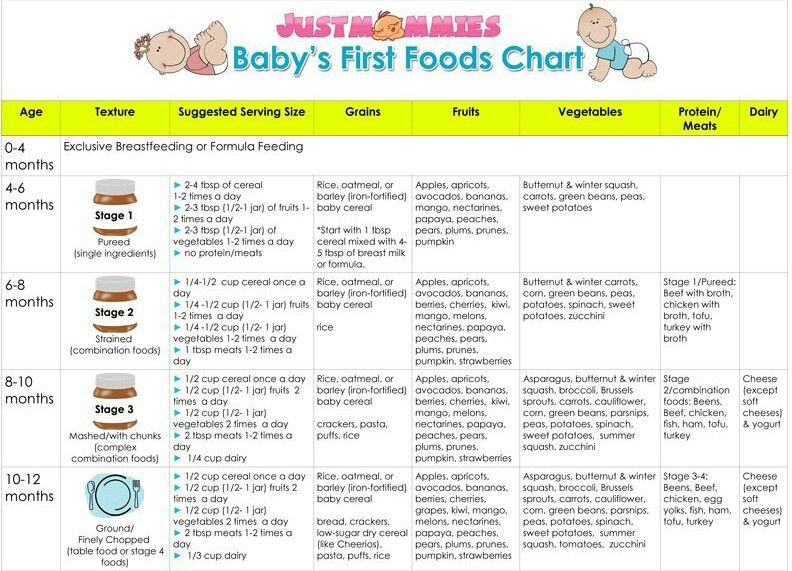 Fortunately, you don’t have to. We've assembled all the necessary details in the chart below, including feeding frequency and portion information.
Fortunately, you don’t have to. We've assembled all the necessary details in the chart below, including feeding frequency and portion information.
related baby tool
Keep an eye on your baby’s average growth by tracking height, weight, and head circumference with our simple tool.
Fill out your baby's details*:
What is your child*
Boy Girl
This is a mandatory field.
Age (between 0 and 24 months)
This is a mandatory field.
Weight (lbs.)
This is a mandatory field.
Height (in.)
This is a mandatory field.
Head circumference (in.)
This is a mandatory field.
*Input details of your baby’s last measurements.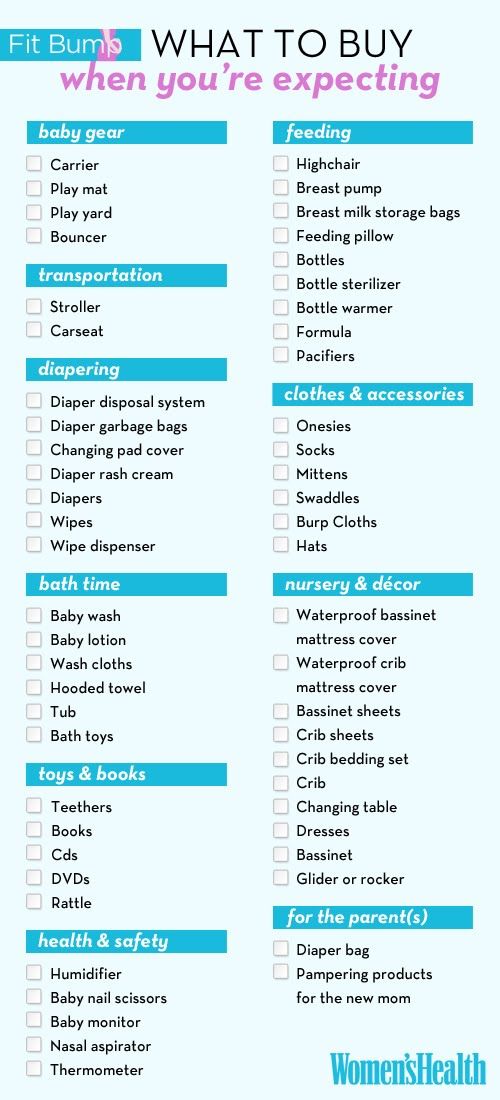 **Source: World Health Organization
**Source: World Health Organization
Feeding Schedule for Breastfed Newborns
From the moment your baby is born, she begins to grow at a surprisingly quick pace. To fuel her development and keep her well fed, be prepared to nurse about every two to three hours.
By the time she’s a week old, your little one may begin to nap for longer periods, giving you more time between feedings. If she’s sleeping, you can maintain your baby’s feeding schedule by waking her up gently when it’s time to feed.
Tips to keep in in mind if you’re breastfeeding:
The length of time between feedings is measured from when your baby begins nursing, not when she stops.
Ensure your little one latches on properly. This can be difficult when you’re starting out, especially for first-time moms, but over time your baby may begin to latch comfortably. Speaking to a lactation consultant could be helpful.
As your baby grows she may nurse at a faster rate.
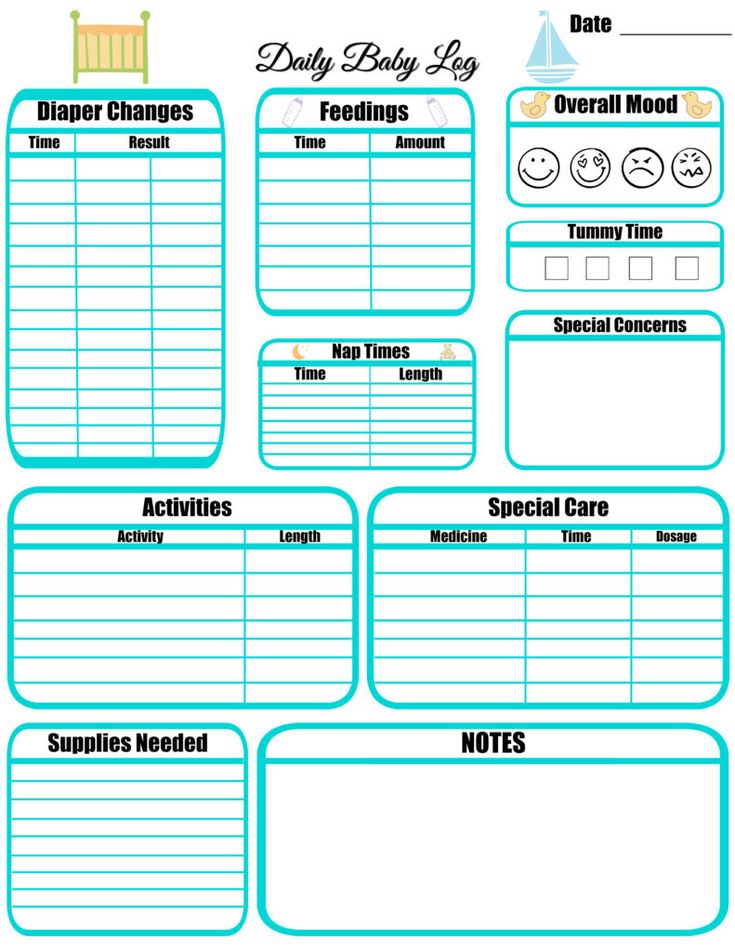
Alternate between breasts during each feeding.
Look for signs that your baby is full. She may turn away from the breast, nurse at a slower rate, or lose interest. Once she seems full, end the feeding
Your baby’s healthcare provider may recommend adding vitamin D oral supplements to your baby’s diet. Follow the provider's instructions to ensure your baby gets the proper dosage.
Nursing your baby on demand or every couple of hours around the clock can seem like a lot—and it is! At the newborn stage, your baby can’t take in much milk in a single sitting, so frequent feeding is needed to make sure she's getting enough. Later on, as your baby's daily routine (including her sleep and awake time) becomes more predictable, you'll have an easier time following a regular feeding schedule.
Feeding Schedule for Formula-Fed Newborns
Formula-fed newborns will need about two to three ounces (60 – 90 milliliters) of formula per feeding to start with. Newborns, fed from bottles are able to take in more during a feeding than a breastfed infants. This allows you to space out feedings by about three to four hours.
Newborns, fed from bottles are able to take in more during a feeding than a breastfed infants. This allows you to space out feedings by about three to four hours.
As your baby reaches her 1-month milestone, she will need at least four ounces per feeding to get the nourishment she requires. Your newborn’s feeding schedule will gradually become more predictable over time, and you’ll need to adjust the amount of formula as she grows.
3-Month-Old Feeding Schedule
Now that you and your baby have begun to develop a routine, it can be difficult to make slight alternations. However, as your baby grows and her feeding needs change, you’ll need to adjust your baby’s feeding schedule accordingly.
For Your Breastfed Baby
At 3 months, your baby is becoming more active, will begin to breastfeed less often, and may sleep for longer periods of time at night.
You may have to nurse just six to eight times per day at this stage (or about every three to four hours).
If your baby’s healthcare provider sees that he’s gaining weight and growing at a regular pace, then he’s probably getting the right amount of nutrition.
The number of wet and soiled diapers is also a great indicator as to whether or not he is eating well. Your baby should have about four to six wet diapers a day.
See your baby’s healthcare provider if you’re concerned that your little one may not be getting enough to eat.
For Your Formula-Fed Baby
As your little one continues to grow, you’ll notice that he wants to eat more during each feeding and begins to sleep for longer intervals at night.
Slight adjustments to your 3-month old’s feeding schedule may include:
Increasing the amount of formula to about 5 ounces per feeding
Giving your baby formula about six to eight times per day
Switching the newborn nipple size or style on your baby’s bottles to make it easier for him to drink from the bottle.
6-Month-Old Feeding Schedule
At this stage, your baby’s healthcare provider may recommend you expand your baby’s diet to include solid foods. With these menu additions on the horizon, having a 6-month-old feeding schedule will come in handy!
With these menu additions on the horizon, having a 6-month-old feeding schedule will come in handy!
When a baby ready to try solid foods, a single grain baby cereal mixed with breast milk or formula has traditionally been the first solid food to be introduced, followed by pureed vegetables and fruits. However, there's no medical evidence that indicates introducing foods in any special order offers any benefits.
Keep in mind that solids are only a supplement at this stage, and that breast milk or formula is still your baby’s most important source of nutrition. Continue to include about 32 ounces of breast milk or formula in your 6-month-old’s feeding schedule of three to five feedings per day to ensure your baby gets the necessary vitamins and minerals.
You may be able to start weaning your baby off of night feedings; however, every baby is unique. Speak to your baby’s healthcare provider to see if it’s time to cut down on nighttime feedings and to learn what you can do to encourage the process.
7 to 9-Month-Old Feeding Schedule
Months seven through nine can be a good time to add a greater variety and quantity of solid foods to your baby’s diet. He may need fewer daytime feedings, now — about four to five.
Purees of meats, veggies, and fruits are recommended at this stage. Introduce your baby to these new flavors as single ingredient purees then gradually add combinations to his meals.
Your baby may slowly begin to wean off breast milk or formula as his growing body demands solid foods for nutrition.
There is no correct time to wean off breast milk or formula. Speak to your baby’s healthcare provider to learn more about the cues and signs that can let you know when your baby is ready for more solid foods.
10 to 12-Month-Old Feeding Schedule
Exploring new textures may now be a big part of your little one’s meals. As he grows, he may begin to self-feed with finger foods such as cut-up bananas, dry cereal, and pasta and even demand certain flavors that he enjoys more.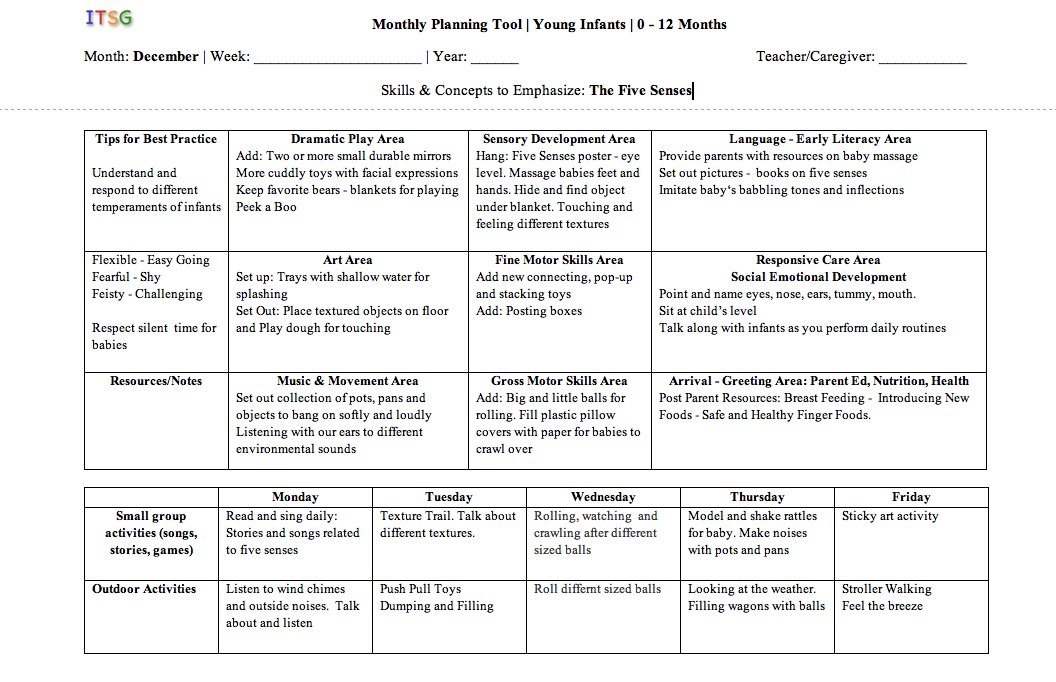
As you continue to replace breast milk or formula with solids, your baby’s healthcare provider can help determine how to balance out your baby’s meals.
Blends of different foods can be introduced during mealtime and added to your baby’s feeding schedule. Your baby may eat about three to four times per day. Be sure to avoid offering foods that pose choking hazards such as grapes, peanuts, and popcorn.
Finger feeding can be fun for your little one. Always be sure that his food is cut up into pieces that are small enough for him to be able to pick up and chew without being at risk of choking. After some practice, he’ll be on his way toward wholesome, independent eating habits.
1-Year-Old Feeding Schedule
Now that you’re celebrating your baby’s first birthday, it’s also time to celebrate his feeding accomplishments. Your baby’s feeding schedule can now include almost all the healthy and nutritious foods you eat, with a few minor exceptions such as raw honey and choking hazards like nuts.
Your baby may be eating less frequently now, as he is able to take in more food in one sitting. Give your 1-year-old approximately three meals and about two or three snacks a day.
This is the time to add cow’s milk to your baby’s diet. However, too much milk is not always good, and should be kept to about 16 to 24 ounces per day if your baby is able to tolerate lactose. Check with your baby's healthcare provider if you have any questions about how and when to introduce cow's milk.
You can continue to nurse your baby if you wish. There is no correct time to wean him off of breast milk; rather, it is recommended that to continue breastfeeding for as long as it is right for you and your little one. Consult with your baby’s healthcare provider if you have questions about the weaning process.
As your baby grows and develops, his feeding needs will change. Having a baby feeding schedule at the ready can help you track your baby’s mealtimes and anticipate when he’ll start to be hungry.
This is just one of the ways you can help keep your little one happy and developing well. Having a feeding schedule in place also gives you some extra freedom to spend more time enjoying his many milestones.
Of course, if at any time you have questions or concerns, reach out to your baby’s healthcare provider for personalized guidance and advice.
Daily routine for a child under 1 year old
Daily routine is a system for distributing periods of sleep and wakefulness, meals, hygiene and health procedures, activities and independent human activities throughout the day.
Compliance with a rational daily routine corresponding to the age characteristics of the child contributes to his healthy growth and development. Getting used to performing various types of activities at the same time, the child is prepared for the upcoming type of activity at every moment of time, which ensures their easier and faster implementation. Compliance with the correct daily routine provides a good mood for the child and maintains a keen interest in the study of the world around him, contributing to his normal motor and psychoverbal development.
The child's daily routine includes the following obligatory elements: diet, time spent outdoors during the day, frequency and duration of sleep, mandatory classes to develop skills in accordance with age, free time.
In the first months after birth, a healthy newborn baby sleeps for most of the day, since all external stimuli are very strong for the nervous system of a child, accustomed to a cozy intrauterine environment, and cause its rapid exhaustion. As the child grows older, the duration of sleep gradually decreases and the time of wakefulness increases.
| Age | Daytime sleep mode | Night sleep | Wake mode |
| From birth to 2 months | 6 x 2.5 hours | 6 hours | During feeding |
| 2-4 months | 5 times 2-2.5 hours | 6.5 hours | 4 x 1.5 hours |
| 4-6 months | 4-5 times for 2 hours | 7 hours | 4 times 2 hours |
| 6-9 months | 3-4 times for 1. 5-2 hours 5-2 hours | 8 hours | 4 x 2.5 hours |
| 9-12 months | 2 x 1.5-2 hours | 9-10 hours | 4 times for 3-4 hours |
Closely related to the sleep-wake mode is the feeding mode of the baby. The sleep of a child in the first months of life is very sensitive and is easily disturbed under the influence of various extraneous stimuli, including hunger.
| Age | Mode | Example |
| From birth to 2 months | 7-8 times, every 3 hours | 6,9,12,15,18,21,24 (no night feeding) |
| From 2 to 6 months | 6-7 times, every 3.5 hours | 6, 9.30, 13, 16.30, 20, 23.30 (without night feeding) 6, 9.30, 13, 16.30, 20, 23.30, 03 (with night feeding) |
| From 7-12 months | 5 times, every 4 hours | 6,10,14,18,22 |
A child's stay in the fresh air is essential in the daily routine. The total duration of stay in the open air for children under 1 year of age should be at least 5-6 hours a day. Fresh air has a calming effect on the baby, improves metabolic processes, and increases the body's defenses. In the summer, all games and activities should be held outdoors; in the cold and transitional seasons, two one-time walks of 1.5-2 hours are provided.
The total duration of stay in the open air for children under 1 year of age should be at least 5-6 hours a day. Fresh air has a calming effect on the baby, improves metabolic processes, and increases the body's defenses. In the summer, all games and activities should be held outdoors; in the cold and transitional seasons, two one-time walks of 1.5-2 hours are provided.
Fresh air also has a beneficial effect on sleep. By acting on the skin and mucous membranes of the nose and upper respiratory tract, it provides a faster fall asleep of the child and a higher quality of sleep. Sleeping outside can replace a walk, especially during the cold season.
The child's daily routine is generally individual, but ideally, one should strive to ensure that the child eats after waking up, and then stays awake until the next sleep. A well-slept baby eats with appetite and then calmly and actively plays or engages, and tired of games, easily goes to sleep.
When your baby is awake, try to keep him active and cheerful. It is necessary to dress the child in loose clothing that does not hinder movement, provide access to toys appropriate for his age, and most importantly, actively participate in games and activities with the baby as a whole family.
It is necessary to dress the child in loose clothing that does not hinder movement, provide access to toys appropriate for his age, and most importantly, actively participate in games and activities with the baby as a whole family.
Author - Physiotherapist - DMITRIENKO T.G.
Approximate daily routine for children under 1 year old
08/21/2018
≈ 4 min reading time
We offer you an approximate daily routine. It will not be suitable for all children, but you can develop your own based on it, making some changes in it after consulting a pediatrician.
Be prepared for the fact that the baby will make its own adjustments, and some of this is not very suitable for you. It's OK. The main thing is to have something to build on. If the schedule has gone astray for reasons beyond your control, try to return to the original version.
Do not forget to include in the schedule not only sleep, feeding and walks, but also hours for games and communication with the child, as well as the time when he can be alone with himself - conditionally, of course, because such babies cannot be left unattended.
Offer your baby healthy and tasty Agusha Zasypay-ka products, which are specially designed for use before bedtime. These are live drinking yogurt with apple flavor and natural lemon balm extract, cottage cheese with strawberry, banana flavor and natural lemon balm extract, as well as cereals with prebiotics and cereals: buckwheat milk and rice milk with apple and pear, which will help your child to tune in to a healthy and deep sleep.
Baby routine 0 to 2 months
At the age of 1 - 2 months, the baby sleeps about 18 hours a day.
- 7:00 a.m. - wake up, water procedures, feeding
- 7:30 a.m. to 9:00 a.m. - awake
- 9:00 - feeding
- From 9:00 to 10:00 - the first morning dream
- 10:00 to 11:00 - active wakefulness
- 11:00 - feeding
- From 11:30 to 12:30 - second morning sleep in a stroller for a walk
- 13:00 - feeding
- From 13:00 to 14:00 - active wakefulness, games
- From 14:00 to 15:00 - daytime sleep in a stroller outside during a walk
- 15:00 - feeding
- From 15:00 to 17:00 - games, wakefulness, communication
- 17:00 - feeding
- From 17:00 to 18:00 - evening sleep
- From 18:00 to 19:00 - quiet wakefulness
- 19:00 - feeding
- From 19:00 to 20:30 - communication
- 20:30 bathing
- 21:00 - feeding, night sleep
At night, you need to feed no more than 1 time in 4 hours.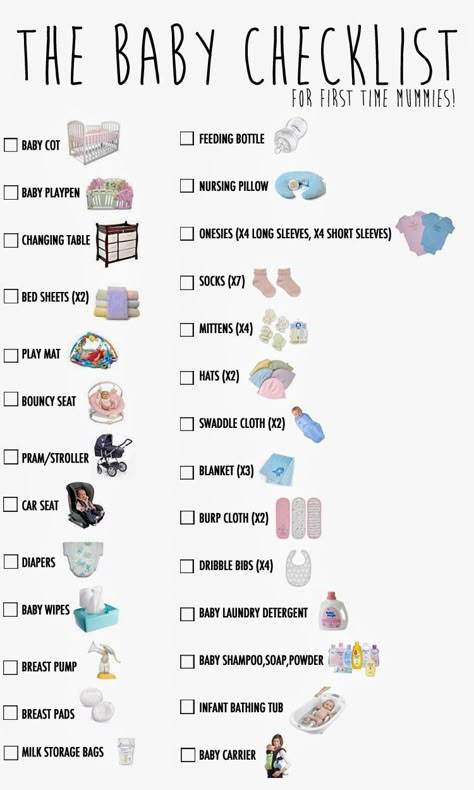
2 to 3 month baby routine
At this age, the baby sleeps noticeably less: there are periods of prolonged daytime wakefulness. The first morning sleep leaves, and when the child does not sleep, he behaves more actively. Day rest is shortened. A night sleep regime is being developed: now its duration is 10-12 hours with breaks for feeding.
If this mode suits everyone and the baby does not have serious objections, then it can be used at 3 months.
- 7:00 a.m. - wake up, water procedures, feeding
- 7:30 a.m. to 9:00 a.m. - awake
- 9:00 - feeding
- From 9:00 to 10:00 - massage, special gymnastics
- From 10:00 to 11:00 - fun and games in the crib
- 11:00 - feeding
- From 11:30 to 12:30 - second morning sleep in a stroller for a walk
- 13:00 - feeding
- From 13:00 to 14:00 - you can learn to crawl
- From 14:00 to 15:00 - daytime sleep in a stroller outside during a walk
- 15:00 - feeding
- From 15:00 to 17:00 - communication with relatives or with everyone who comes to visit
- 17:00 - feeding
- From 17:00 to 18:00 - evening sleep
- From 18:00 to 19:00 - reading fairy tales and poems, listening to calm music
- 19:00 - feeding
- From 19:00 to 20:30 - toys
- 20:30 bathing
- 21:00 - feeding, night sleep
4 month old baby routine
At 4 months, the baby is almost an adult. Therefore, the mode can be adjusted. First, you need to reduce the number of feedings (now this can be done every 3 or even 4 hours, depending on the needs of the child). Secondly, evening sleep ceases to be a "mandatory item on the program." At this age, it can, on the contrary, interfere with night rest. Now the child sleeps 17 - 18 hours a day. And the third thing to do is to enter the ritual of going to bed (of course, if you have not done this before). Daily baths, quiet games, lullabies and even a simple kiss goodnight will help with this.
Therefore, the mode can be adjusted. First, you need to reduce the number of feedings (now this can be done every 3 or even 4 hours, depending on the needs of the child). Secondly, evening sleep ceases to be a "mandatory item on the program." At this age, it can, on the contrary, interfere with night rest. Now the child sleeps 17 - 18 hours a day. And the third thing to do is to enter the ritual of going to bed (of course, if you have not done this before). Daily baths, quiet games, lullabies and even a simple kiss goodnight will help with this.
- 7:00 - wake up, water procedures, feeding
- 7:30 a.m. to 9:00 a.m. - awake
- 9:00 - feeding
- From 9:00 to 10:00 - massage, gymnastics
- From 10:00 to 11:30 - fun and games in the crib
- From 11:30 to 12:30 - second morning sleep in a stroller for a walk
- 13:00 - feeding
- From 13:00 to 14:00 - educational toys
- From 14:00 to 15:00 - daytime sleep in a stroller outside during a walk
- From 15:00 to 17:00 - communication
- 17:00 - feeding
- From 17:00 to 19:00 - reading fairy tales and poems, listening to calm music
- From 19:00 to 20:30 - toys or an evening walk (at your discretion)
- 20:30 bathing
- 21:00 - feeding, night sleep
5 month baby routine
The mode of sleep, wakefulness and feeding during this period is often rebuilt.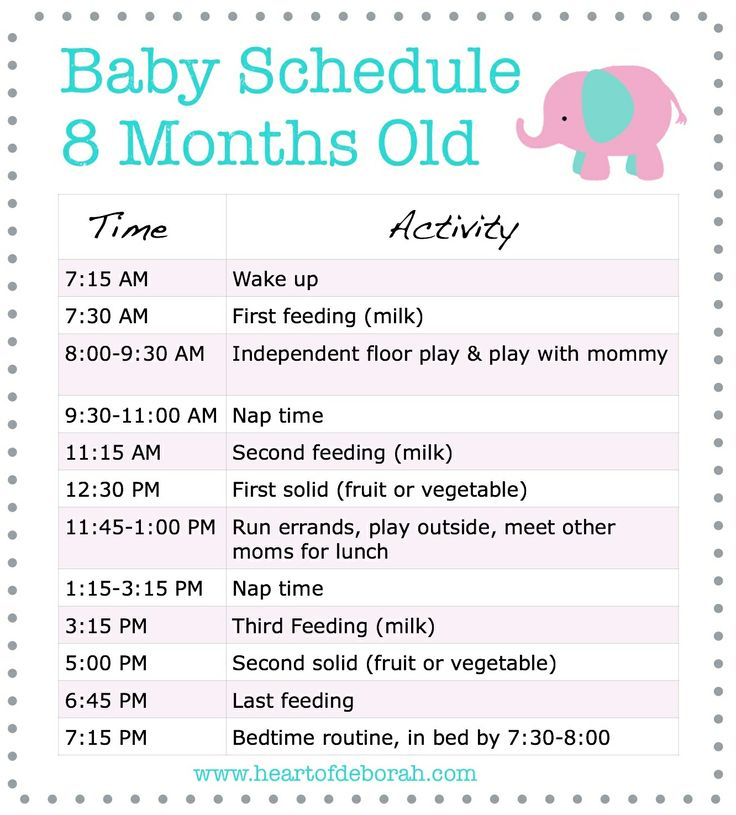 Sometimes the baby can sleep through the night without getting up for feeding, or wake up very early and not go to bed in the morning. At 5 - 6 months, the baby should sleep about 16 hours a day.
Sometimes the baby can sleep through the night without getting up for feeding, or wake up very early and not go to bed in the morning. At 5 - 6 months, the baby should sleep about 16 hours a day.
- 8:00 a.m. to 8:30 a.m. - wake up, water procedures, feeding
- 10:00 - sleep
- From 11:00 to 13:00 - feeding, walking, games
- 13:00 - daytime sleep
- 14:00 - feeding, games
- From 17:00 to 17:30 - feeding, sleeping
- From 17:30 to 18:30 - games
- 18:30 bathing
- From 19:00 to 19:30 - feeding
- 20:00 - night sleep
Child's daily routine at 6 months
At the age of 6 months, the baby can wake up at night - this is due to the abundance of impressions. Parents need to calm the child, and he will quickly fall asleep again. Experts also advise putting him to bed half an hour earlier: this can reduce the number of night awakenings.
Now the time of total sleep per day is the same - about 16 hours, while there should be three daytime sleeps, 1.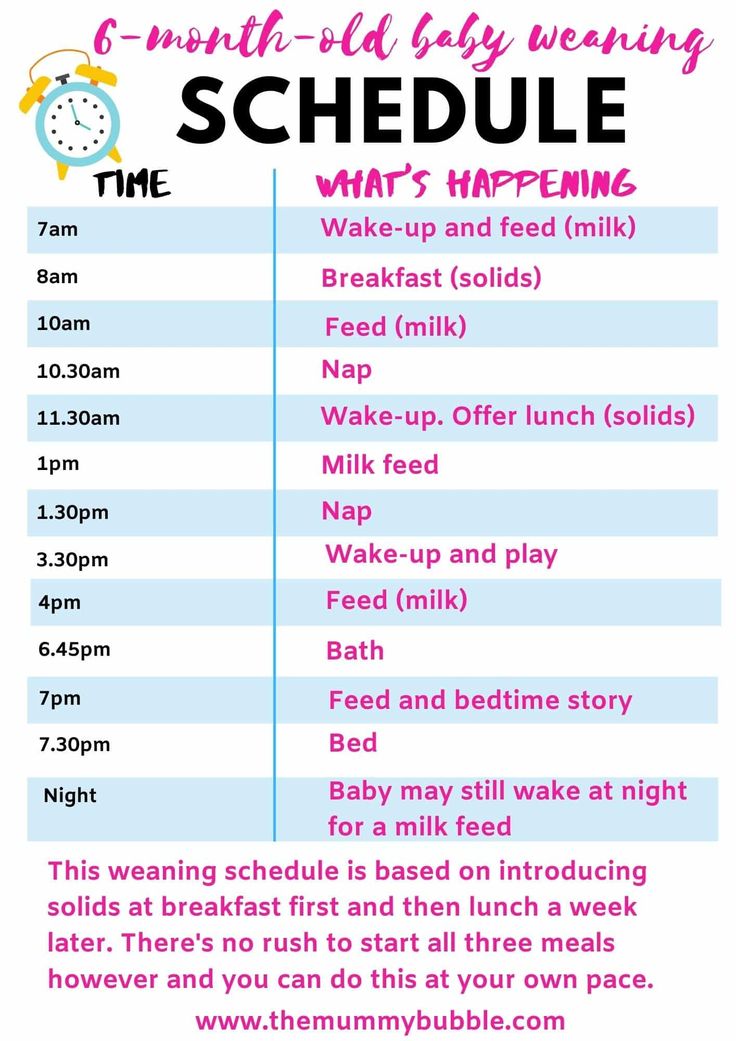 5 - 2 hours each. If the baby is already teething, then he can wake up 2-3 times a night. In this case, he must be fed.
5 - 2 hours each. If the baby is already teething, then he can wake up 2-3 times a night. In this case, he must be fed.
- 7:00 - wake up, water procedures, feeding
- 8:30 - breakfast, sleep
- 10:00 - wake up, walk about 90 minutes
- 12:30 - feeding, play, sleep
- 15:00 - awakening, feeding, educational games
- 17:30 - feeding
- 20:15 - dinner, bathing, socializing
- 20:45 - night sleep
7 month baby routine
At this age and up to 9months the child sleeps about 15 hours a day. If the baby wakes up at night, talk to him quietly, calmly, and he will fall asleep again.
- 7:00 - wake up, water procedures, feeding
- 7:30 am family breakfast
- 8:30 - sleep
- 10:15 - feeding, walking
- 11:30 - lunch
- From 12:45 to 14:30 - afternoon nap, feeding, walk
- 17:15 - dinner and games
- 18:00 - feeding
- 18:30 - bathing and getting ready for bed
- 19:00 - night sleep with feeding breaks at 2:30 or 3:00 and at 4:30 or 5:00
8 month baby routine
At this age, the baby begins to painfully experience separation from his mother, so it is important to organize the child’s sleep so that he sees his mother when he wakes up.
- 7:00 - wake up, water procedures, feeding
- 8:00 - first dream
- 9:30 - feeding
- 10:30 - games, walk
- 14:00 - feeding
- 2:15 pm - second dream
- 16:30 - games, wakefulness, communication
- 18:00 - feeding
- 18:15 - games, being awake, socializing
- 19:00 - bathing and getting ready for bed
- 19:30 - third dream
- 22:00 - feeding
- 22:15 - night sleep
Child's day routine at 9months
From 9 to 12 months, the baby, as a rule, sleeps at night for 10 - 12 hours without a break, and also 2 times a day for 1.5 - 2 hours. At this age, it is very important for him to fully restore his strength - this is of great importance for the development of the child.
- 8:00 a.m. to 9:00 a.m. - wake up, water procedures, feeding
- 9:30 am - breakfast
- 10:00 to 11:00 - games
- 11:00 - short nap
- From 12:00 to 13:00 - feeding
- From 13:00 to 14:00 - games
- 14:00 - snack
- 2:30 pm to 4:00 pm long nap
- From 16:00 to 17:00 - feeding
- 18:00 - games
- 18:30 - dinner
- From 19:00 to 20:00 - games
- 20:00 - bathing, feeding (drink)
- 21:00 - night sleep
10 month old baby routine
From 10 to 12 months, the baby sleeps about 13 hours a day, in his regime there are 2 daytime sleeps, one of which falls in the morning.
- 7:00 - wake up, water procedures, feeding
- 8:00 am - breakfast and games
- 9:00 to 10:00 - feeding and sleeping
- 11:00 - wake up and feed
- 12:00 - lunch and games
- 13:40 - afternoon nap, feeding
- 15:30 - feeding, playing, walking
- 17:40 - lunch, games, bathing
- 19:00 - getting ready for bed, communication
- 20:00 - bathing, feeding (drink)
- 21:00 - night sleep
Child's daily routine at 11-12 months
At this age, the regime is already formed, and it is especially important to stick to it. If the baby is put to bed later than usual, he will wake up at night, sleep restlessly and will not be able to rest well.
- 7:00 a.m. - wake up, water procedures, feeding
- 8:30 - breakfast, games, reading books
- 10:00 - rest, sleep
- 11:30 - feeding, playing, walking
- 12:30 - lunch, games, books
- 14:00 - afternoon nap
- 15:00 - wake up, feed, play
- 17:30 - dinner, games
- 18:30 - rest, bathing
- 20:00 - bathing, feeding (drink)
- 21:00 - night sleep
And from the year the baby begins a new period in life, requiring a different regimen.




